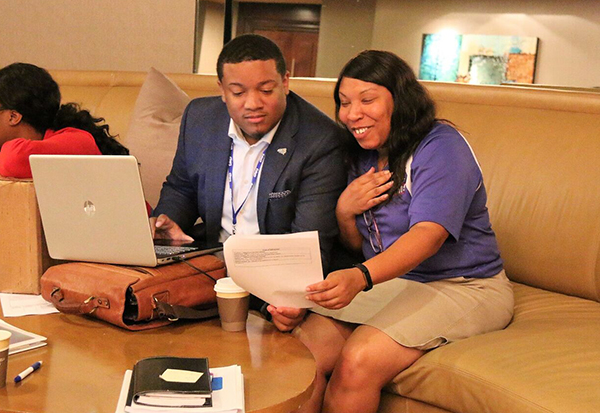TAP Summer Institute 2017: Setting Goals and Creating a Plan to Reach Them
August 14, 2017

Educators from across multiple states gathered this summer at the TAP Summer Institute (TSI) in Dallas to review student data, refresh their skills, and set school goals for the coming year. Working in district and school teams, they analyzed student achievement results from last year and strategized how to continue to drive higher achievement and close gaps. TSI also provided an opportunity for educators to build connections and learn from colleagues successfully tackling similar challenges in other districts and states.
Goal Setting
The opening training session focused on the importance of goal setting and its role in supporting transformational change and improvement. Educators analyzed their district or school data, allowing them to apply lessons and best practices learned in NIET trainings to their unique student populations, needs and goals.
In the opening training, teams focused on three questions.
1. What?
Educators used data to identify what needs to be addressed in the coming year. What was done well in the past year? What are the areas for refinement and improvement?
Trainers worked with participants to answer the question: What does the data show that you need to address this coming year?
2. How?
Each team discussed how to meet these needs. For example, a middle school might set a school goal of increasing student achievement and student progress measures by 8% across all content areas as measured by various assessments. Breaking this down further in math, for example, the school team might set specific targets for increasing the percentage of students reaching advanced and satisfactory in each grade level, as well as for reducing the number of students scoring unsatisfactory in every grade level. The same kinds of goals are set for reading or other areas of focus.
To support these student learning growth goals, the team creates annual cluster goals as well as cluster cycle goals that further identify key skills that will drive these gains. The yearly cluster cycle goal, in one example, was making inferences and drawing conclusions in informational texts skills, as measured by nine weeks' assessments. Cluster cycle goals further break down the subskills students need to master to make steady progress over the course of the year to meet this goal.
These goals are also driven by student needs. For example, while addressing the student need in cluster, teachers focus on how their specific teacher goals (tied to the rubric indicators) can have an impact on students successfully mastering their goals. Case-in-point: Teachers may ask, "How can improving my Questioning skills impact students mastering the identified need?"
3. Why?
Participants connected the research on the importance of goal setting with their experience with students. The power of goal setting includes:
- Goals focus student attention on the learning task and learning target
- Goals stimulate appropriate student effort
- Goals increase student persistence
- Goals increase a student's desire and capacity to learn new strategies
Participants discussed the value of clear and detailed goal setting, and how to communicate and talk about learning goals within their school community to build greater understanding of the what, how and why that will lead to success this coming year.
Next Steps
In addition to analysis, planning and goal setting, TSI provided an opportunity for educators to strengthen their networks and learn from colleagues across the country.
As one participant noted, given TAP's 20-year history, "We are seeing the career ladder really have an impact. TAP educators are moving into new roles and in new locations. They are expanding the reach of their skills in supporting significant and sustained improvement in teacher practice and student achievement across the country."